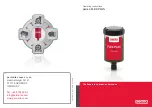
G01
SPD Owner's Manual
23
the RO elements be replaced.
The old AAMI-ANSI dialysis standard recommends that elements be replaced when the salt passage (1
- rejection %) doubles in value. Since typically the rejection of thin film composite RO membranes when
new is 98%, this means replacing the elements at 96% rejection.
Actually the minimum level of rejection needed to meet AAMI ionic contamination limits is dependent
upon the chemical analysis of the treated feed water to the RO system. Some rare and pure feed
waters would meet ionic standards with no rejection in the membrane. In contrast, a feed water supply
with a high level of fluoride or nitrate would require a high rejection of the membrane in order to meet
ionic standards.
Decrease in the system rejection should thus be interpreted in conjunction with increases in the level of
problem ion as reported on by a chemical analysis of the product water.
Removal:
The control panel cover, the right side module access cover, and the rear module cover must
all be removed for module replacement. It will be necessary to remove the external water connections
to the unit. The SPD unit may have to be moved to access the rear.
First disconnect the product tubing assembly. Remove the tubing from the instant fitting unions at the
top of each module.
To remove a module, first undo the ¼” tubing to the annulus drain by removing the red clip and then
using a ¼” end wrench to push down of the collar. Pull out the tubing. The compression nuts at the top
and bottom sides must then be removed. Remove the bottom tubing piece first and thread on a 1" FPT
cap to minimize spillage. Use a small pipe wrench to grab the tubing compression nuts. Then loosen
the SS band clamps at top and bottom. Carefully pull out the module.
Disassembly of Module:
The RO spiral wound element must be removed from the pressure vessel for
replacement.
First, holding the module upright, drop it about 6 inches onto a hard floor. This will allow the top end
cap to slide slightly downward and relieve pressure on the plastic snap ring.
With fingers or pliers, pull end knob of plastic snap ring at top of module inward. Once it is started the
snap ring will slide out of the groove all the way around. Set the snap ring aside.
Now the end cap must be pulled out of the vessel. Sometimes you can just pull on the outlet fitting and
the cap will slide out. With care one can grab one of the spokes with pliers. If the end cap is resistant it
may have to be pushed out with water pressure. To do this connect a tap water supply to bottom side
port on module. After water starts exiting the top side port, turn off water and cap this port. Turning the
water on again will push the end cap out. Lay the end cap and the large "O" ring aside.
The element can now be pulled out of the vessel. If it is stuck, the module can be turned upside down
and dropped several inches to release the element.
Assembly of Module:
The RO element has three important seals that must be made in order to
function properly. The central product tube seals into the top module end cap with a small "O" ring
inside the end cap. The perimeter of the element seals to the inside of the pipe vessel section with a
Содержание SPD2H
Страница 2: ......
Страница 11: ...G01 SPD Owner s Manual 9 FIGURE 5 ...
Страница 22: ...G01 SPD Owner s Manual 20 FIGURE 7 ...
Страница 33: ...G01 SPD Owner s Manual 31 ...
Страница 35: ...G01 SPD Owner s Manual 33 Appendix 1 Keyence Ladder Program ...
Страница 36: ...G01 SPD Owner s Manual 34 ...
Страница 37: ...G01 SPD Owner s Manual 35 ...
Страница 38: ...G01 SPD Owner s Manual 36 ...














































